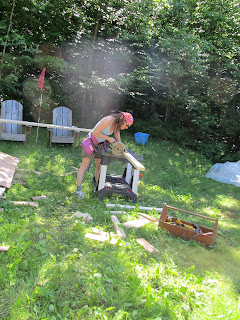I finally managed to get the tar paper up to cover the sheathing:
I found out a couple things about tar paper that I didn't know. The first is that it's surprisingly brittle - it looks like it should behave like paper, but it will actually crack if you handle it wrong. The second is that the stuff stinks. It smells horrible!
Hanging big chunks of tar paper by yourself can be a bit of an adventure. Down low, it wasn't hard to do. I just had to unroll a suitable length, cut it and tack it up. Once I was higher up, it got to be a real drag. The procedure is as follows:
1. Measure length of area to be covered
2. Unroll and cut tar paper to lenght
3. Move ladder to end of area to be covered
4. Climb ladder with tar paper
5. Reach for hammer tacker in toolbelt
6. Drop hammer tacker from top of ladder
7. Climb down, retrieve hammer tacker
8. Climb back up
9. Tack one end of tar paper
10. Climb down, move ladder
11. Tar paper falls off
12. Curse bitterly (repeat this step often)
13. Replace tar paper
14. Move to other end
15. Tack up that end
16. Nail up tar paper
A hammer tacker is a fun tool - it's a cross between a stapler and hammer. Basically it's a stapler operates on the force of your swing rather than the force of a built in leaf spring.
It'll happily drive staples into plywood, where my basic staple gun failed miserably. It's also pretty ruggedly constructed - the back of it makes a handy hammer for driving home any staple that a feeble initial hit didn't sink. The only problem with it is that it doesn't fit nicely into my tool belt. It's a solid chunk of metal, and it has a tendency to tumble out of the pocket at inopportune moments. I'm guessing a dedicated holster would be the way to go.
I ended up securing the tar paper with cap nails. These are basically just little nails with big plastic heads attached - they hold the paper more securely than a regular roofing nail. The research that I did indicated that if the tar paper is going to be exposed for a while, that these would probably be a safer bet.
 |
| Note the wreckage that is our backyard in the background... |
The other nice thing about the cap nails is that there's a very clear visual indication of the location of the studs, which'll come in handy when we're putting up the siding.
The inside is starting to come back together, too. The old door was made by Peachtree, and was an odd size - a little wider and a little shorter than a "standard" door. When we installed it, we tightened up the rough opening with a 2x4 and a half-inch plywood strip on each side to bring it in to the dimensions required by our new door. This left a big chunk of exposed framing on either side. I had originally thought to just cover it all with trim, but in the end I decided to cover it with wallboard.
My mudding and taping skills are pretty weak, but in the end it'll be fine.
While we were waiting for the first layer of mud to dry, the kids and I reinstalled the floor grate. This allows heat from the wood stove to reach the upstairs, where it was then promptly released to the outside by our old door. Hopefully this door does a better job. It's interesting - it's impossible to get kids interested in eating vegetables or cleaning their room, but if you tell them they can cut a big hole in the floor, they can't wait to help.
My coworkers:
First, we drilled holes in the corners:
Then we connected the dots with the jigsaw:
Done!
Nailing up a bit of blocking under the sill:
Naomi was struggling with the nailer - it weighs about half of what she weighs.
All in all, a reasonably productive weekend. Next weekend, I'm hoping to get the interior of the door trimmed up, and then start on backyard cleanup.






















































